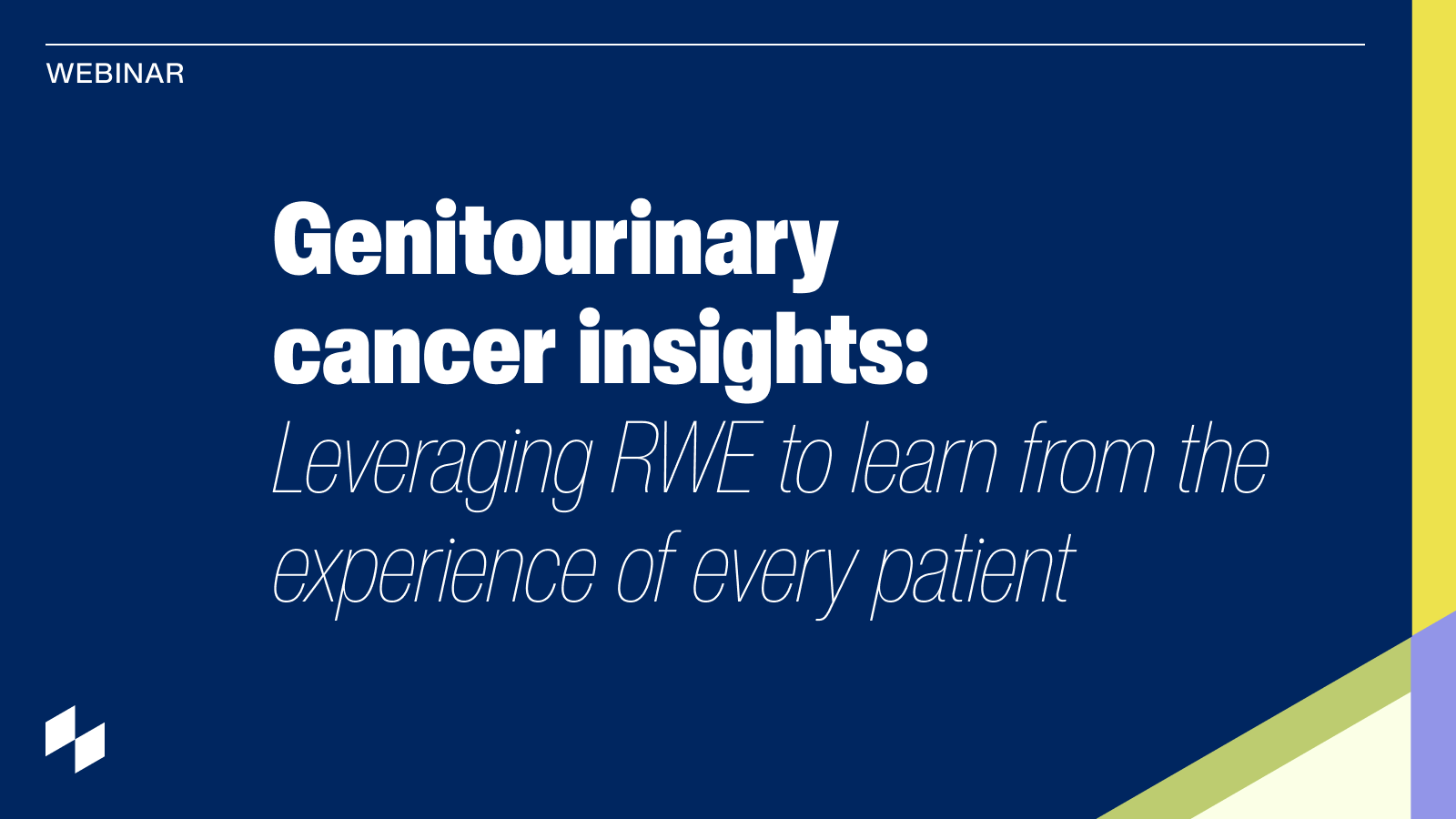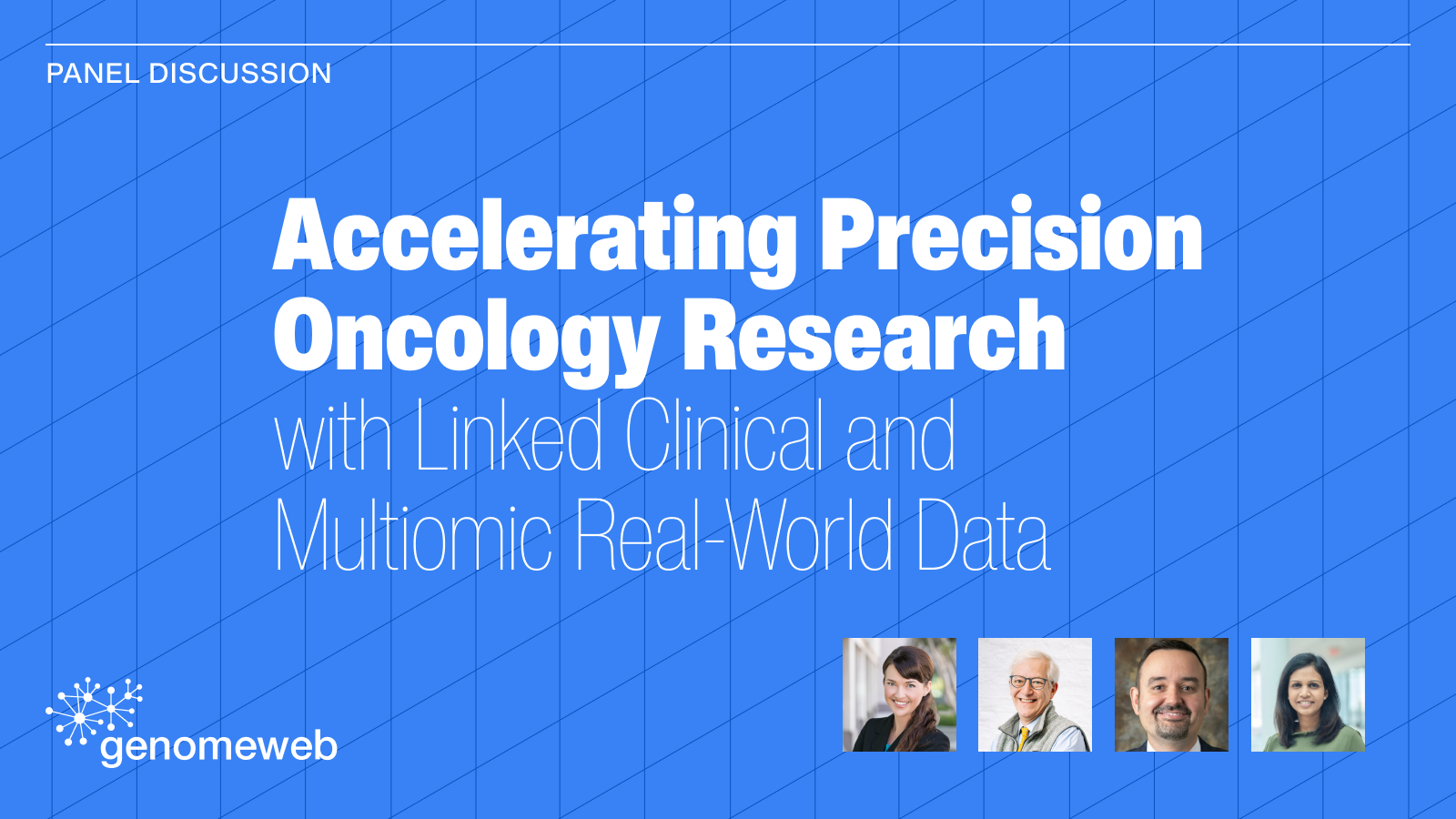As tumor-agnostic therapies become a new treatment paradigm in oncology, real-world evidence that offers insights into molecular profiles and clinical outcomes in pan-tumor populations is even more vital in the context of precision oncology. This session showcases industry perspectives highlighted by pre- and post-market use cases to discuss the value of RWE across the tumor-agnostic drug development life cycle.

Questions from the audience
Could you comment on your team's decision to use real-world data for this study as opposed to from another data source? Do you see it becoming a more regularly considered option to supplement learnings from basket trials for rare tumors or multi-tumor cohorts?
Chelsea Shao: Thank you for the question. So at Merck we actually always start with the strategy and the research questions. We will evaluate as a team to see what's the best approach to address the research question. Certainly in this case, because our question is the TMB prognostic effect across these 10 uncommon tumor types, these Flatiron pan-tumor data sets include every one of these 10 tumor types with reasonable sample size. And also Foundation Medicine, I say for the TMB testing is quite consistent with the methods used for our KEYNOTE-158 to trial for the TMB measurement. So that's why we believe this is fit for purpose to understand the prognostic value for TMB across these 10 tumor types.
So actually, the second question, with the emerging real-world data sets, such as the clinico-genomic data sets, and also a lot of improvements of the data quality, methodology, technology, I do think that there will be a broader application of real-world data in this oncology arena, and especially for the rare tumors or understudied populations. Of course, we need to consider... The data needs to be fit for purpose and should have the sound study designs, close communications and et cetera. I do think the real-world data is an important component part with the totality of the evidence. Thank you.
How do we support the dialogue around a more pragmatic approach to evidence with regulators and payers?
Mike Spencer: I think part of it is obviously having those direct dialogues, whether it's through industry association, whether it's engaging with scientific debates at meetings, et cetera. As I refer to, I do think there's also a need for us to support the evidence base for these approaches to be able to hopefully do some of the work that I know is ongoing around validating what we see within clinical trials with what we see within real-world data sources. Being able to try to show that we can get out of the clinical trial paradigm in certain cases, and be able to show the limitations of that as well as to where it is appropriate.
And then I think that we can support that move to more pragmatic approach. We've seen an enormous amount of movement, particularly from the regulators, who maybe have somewhat different incentives. But we are seeing also on the HTA and payer side a move to be more accepting of these methods, but we've got a way to go, I think.
What is Flatiron's approach to capturing clinical variables that are typically defined for a single tumor type in a tumor-agnostic cohort?
Tamara Snow:
So typically, Flatiron's designs our data models in a disease-specific way. So for this, we really collaborated very closely with our clinicians and our clinical data experts in designing a different approach where we're capturing the same data element across a pan-tumor cohort. So think there were a few things that enabled us to develop this novel approach to abstraction in both a scalable way that still upheld data quality.
So first was designing a flow of abstraction that just makes it easier for abstracters to digest and capture this information from the patient's chart regardless of their tumor type. For example, the first question we have an abstract to answer is whether or not the patient has a solid versus a heme malignancy. And then pending their response to that, they get queued to the next set of questions specific for either solid or heme tumors.
So, we slowly filter them down into more nuanced data elements like stage at initial diagnosis to make it easier to capture those more complex data elements. And then I think another important point is that we're making sure that we're designing policies and procedures for abstracters in a way that allows us to capture that same data element in a harmonized way, without overlooking important tumor-specific nuances. As I mentioned, we're capturing stage on initial diagnosis across the tumor-agnostic data model.
We understand that how this is defined and captured in the EHR can vary across diseases. So we've developed a standardized approach that also calls out or counts for tumor specific nuances. For example, cancers of the CNS do not typically have a numerical group staging. So we note that in our modules, we train our abstracters to expect that when capturing information on those patients. And then the third point, and probably the most important is that what's really core to a lot of Flatiron's abstracted data models is having a robust process for both training and testing abstracters before they are clear to abstract any new module, as well as a QA/QC measures to ensure that abstraction is done correctly. And we're continuously monitoring that data quality.
So, this approach in to abstraction really makes sure that abstracters are comfortable with abstracting this novel data model before launching it and scaling it. And so I really think this methodology to data abstraction designed by our experts internally, really enabled us to abstract these clinical variables that are typically defined for single tumor type in a tumor-agnostic cohort.
What opportunities lie ahead to make genomic testing an essential element of treatment planning across more tumor types, and even when approved, targeted therapies are not available?
Jeff Venstrom:
Yeah, thank you, Olivier, for that question. It's something that definitely keeps me up at night and is I think really relevant for patients as we think about what is the role of comprehensive genomic profiling for different diseases. I think one just fundamental opportunities include education and level setting on what is the added value of getting something like an NGS-based profile, rather than single biomarker testing in specific diseases that could inform treatment sequences, that could inform opportunities for clinical trial enrollment. So I do believe that first and foremost, there's a huge education piece around the role of broad genomic profiling and testing in the clinic that's really tumor-agnostic or across the horizon for multiple different tumors.
Two other areas from a research perspective that I think are also big opportunities is in the early disease setting. So asking the questions for de novo, patients that are potentially diagnosed with curable malignancies, a lot of our current testing patterns are in really late stage advanced metastatic disease, where you're looking for your last option. Thinking and asking the question, what is the role for immediate first testing of using genomic profiling for patients newly diagnosed is an active area of research and really important, I think as an emerging opportunity.
From a data perspective too, we're really excited and love to partner with others around understanding the role of bringing some of this clinical genomic data into molecular tumor boards and as innovative clinical decision support tools too. This is also another active area of research and questions that we're asking internally and love to identify partners too to really help what is the potential role in the clinic tomorrow for asking these questions using clinico-genomic data, particularly for potentially rare patients or patients that you're trying to make a decision that has a rare histology or rare genomic alteration and there's not much data available in the literature. So those are three active areas that I think are opportunities that we're excited about advancing.
So, ideally, what does the future of tumor-agnostic real-world data look like for you? Jeff, from a data availability perspective. Tamara, from a data development standpoint. Chelsea, for applying it in the drug development lifecycle. And finally, Mike, to overcoming market access hurdles.
Jeff Venstrom: Sure, just really quickly, in the interest of time, I guess two areas is one really expanding the access to very different outcomes, and data components. I think some of the questions that have come up in the chat too around different imaging modalities, different capabilities, I'd love to see more patient reported outcome data available in the real-world setting for application, for decision-making. And then also the call that get you driving towards that regulatory grade real-world data products to really enable additional totality of evidence for regulatory drug submissions.
Tamara Snow: Great. I'll also try and keep it short. So on top of continuing to develop additional data elements to unlocking tumor analysis like a pan-tumor line of therapy approach, I think it'll be important for us to ensure that we're providing a data set that allows for both the tumor-agnostic view as well as the disease-specific deep dives, to really ensure that researchers can tease out how effectiveness might vary across the different sub cohorts, especially within a real-world setting.
And then the second thing that I think will be important is making sure that we're building out really robust analytical guidance for researchers using our data, not only clearly defining what the various data elements mean, and how they're defined across diseases, but also how to run a real-world data analysis in a tumor-agnostic cohort. So folks have lots of really interesting questions in the chat. I know some things like considerations for how to decide what index date you should use when looking at an overall survival analysis across a tumor-agnostic cohort is one important point for us to be thinking about moving forward.
Chelsea Shao: Great, so just to try to keep it in short. So yeah, the real-world data definitely is very helpful throughout to the clinical development lifecycle including to understand the disease epidemiology, biomarker epidemiology, to identify the target population, to understand the current treatments and also outcomes, et cetera. So after the drug is on market, certainly the real-world data are very helpful for the safety effects we need to study and et cetera. But certainly, we need to keep in mind that everything should come from the strategy and what's the research question, what data fit for that purpose and et cetera. Thank you.
Mike Spencer: So probably a good job to be last because I think everything has been said, Olivier, and we're over time. I think that last point around being able to follow from the pre-launch into the launch phase, and actually be able to see the objectives at scale across multiple countries in the real-world once the treatment's available, I think that would probably be the additional thing that I would just add to.


